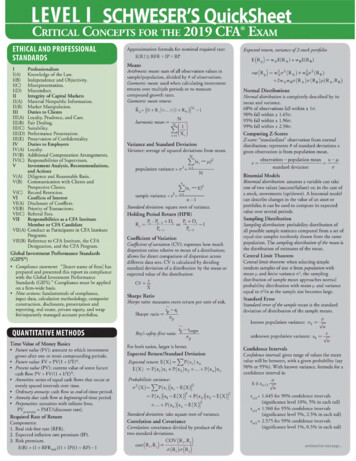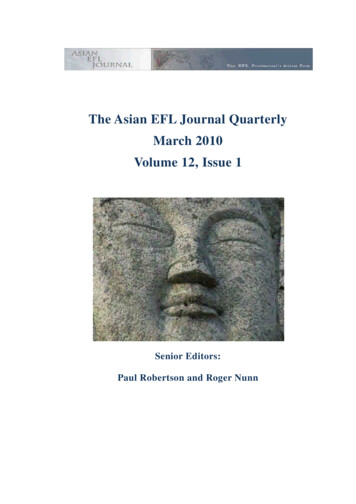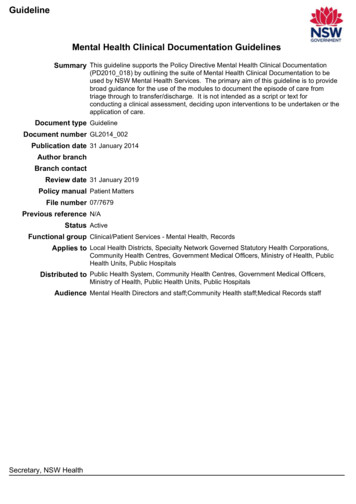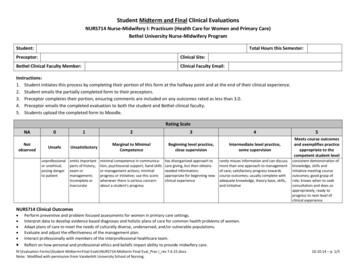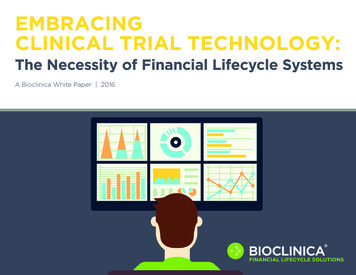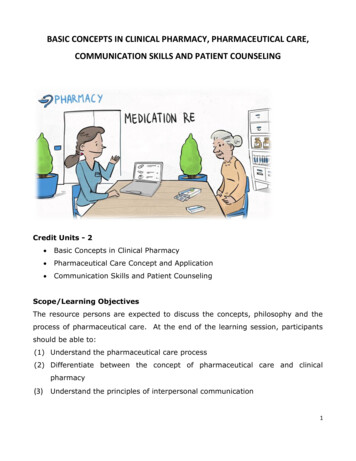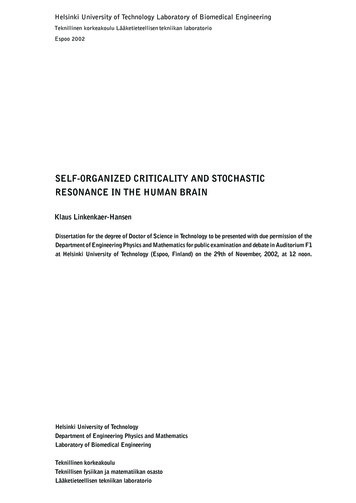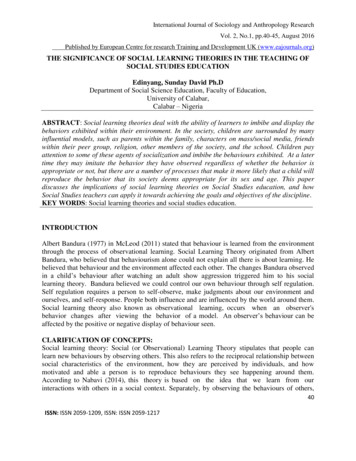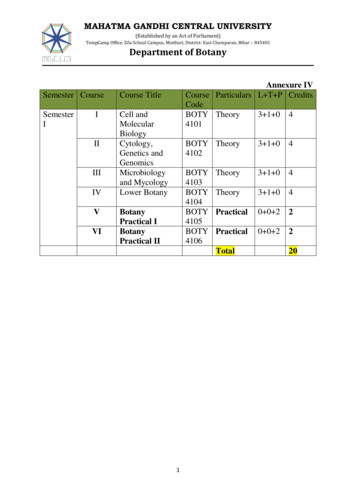![Clinical Significance Of Incidental [18 F]FDG Uptake In The .](/img/32/s12876-016-0545-x.jpg)
Transcription
Shmidt et al. BMC Gastroenterology (2016) 16:125DOI 10.1186/s12876-016-0545-xRESEARCH ARTICLEOpen AccessClinical significance of incidental [18 F]FDGuptake in the gastrointestinal tract on PET/CT imaging: a retrospective cohort studyEugenia Shmidt1, Vandana Nehra2, Val Lowe3 and Amy S. Oxentenko2*AbstractBackground: The frequency and clinically important characteristics of incidental (18)F-fluorodeoxyglucose ([18 F]FDG)positron emission tomography (PET) uptake in the gastrointestinal tract (GIT) on PET/CT imaging in adults remain elusive.Methods: All PET/CT reports from 1/1/2000 to 12/31/2009 at a single tertiary referral center were reviewed; clinicalinformation was obtained from cases with incidental (18)F-FDG uptake in the GIT, with follow-up through October, 2012.Results: Of the 41,538 PET/CT scans performed during the study period, 303 (0.7 %) had incidental GIT uptake. Themost common indication for the PET/CT order was cancer staging (226 cases, 75 %), with 74 % for solid and 26 % forhematologic malignancies. Of those with solid malignancy, only 51 (17 %) had known metastatic disease. The mostcommon site of GIT uptake was the colon, and of the 240 cases with colonic uptake, the most common areas ofuptake were cecum (n 65), sigmoid (n 60), and ascending colon (n 50). Investigations were pursued for the GITuptake in 147 cases (49 %), whereas 51 % did not undergo additional studies, largely due to advanced disease. Therewere 73 premalignant colonic lesions diagnosed in 56 cases (tubular adenoma, n 36; tubulovillous adenoma with lowgrade dysplasia, n 27; sessile serrated adenoma, n 4; tubulovillous adenoma with high grade dysplasia, n 3; villousadenoma, n 3), and 20 cases with newly diagnosed primary colon cancer. All 20 (100 %) patients with malignantcolonic lesions had a focal pattern of [18 F]FDG uptake. Among cases with a known pattern of [18 F]FDG uptake, 98 %of those with premalignant lesions had focal [18 F]FDG uptake. Eighteen (90 %) of the cases with newly diagnosedcolon cancer were not known to have metastatic disease of their primary tumor. Areas of incidental uptake in theascending colon had the greatest chance (42 %) of being malignant and premalignant lesions than in any other area.Conclusion: Focality of uptake is highly sensitive for malignant and premalignant lesions of the GIT. In patientswithout metastatic disease, incidental focal [18]FDG uptake in the GIT on PET/CT imaging warrants further evaluation.Keywords: 18 F-fluorodeoxyglucose ([18 F]FDG), Positron emission tomography/computed, Tomography (PET-CT),Incidental colorectal lesionsBackgroundPositron emission tomography (PET) is a nuclear imagingtechnique that has been widely used in oncology for thedetection of neoplasia [1]. In 1998, the Centers for Medicare and Medicaid Services (CMS) approved coverage forPET imaging in the evaluation of indeterminate solitarypulmonary nodules and initial staging of lung cancer. Sincethat time, CMS has expanded its coverage for various* Correspondence: oxentenko.amy@mayo.edu2Division of Gastroenterology and Hepatology, Department of InternalMedicine, Mayo Clinic, Rochester, MN, USAFull list of author information is available at the end of the articleinvestigations of different types of cancers includingbreast, lung, colorectal, esophageal, head and neck,lymphoma and melanoma [2]. The use of PET imagingcontinues to increase, and is now standard in oncologicpractice.Fluorine-18 fluorodeoxyglucose ([18 F]FDG) is themost commonly used radiolabeled tracer in PET scans.[18 F]FDG is taken up intracellularly by various tissuesand accumulate during glucose metabolism, which occurs at a relatively higher rate in cancer cells. However,cancer cells are not the only cells that are metabolicallyhyperactive. Inflammation, infection and other non- 2016 The Author(s). Open Access This article is distributed under the terms of the Creative Commons Attribution 4.0International License (http://creativecommons.org/licenses/by/4.0/), which permits unrestricted use, distribution, andreproduction in any medium, provided you give appropriate credit to the original author(s) and the source, provide a link tothe Creative Commons license, and indicate if changes were made. The Creative Commons Public Domain Dedication o/1.0/) applies to the data made available in this article, unless otherwise stated.
Shmidt et al. BMC Gastroenterology (2016) 16:125neoplastic conditions such as hyperplastic colorectalpolyps can lead to increased 18 F- FDG accumulation[3]. For this reason, PET scans have a high sensitivity buta low specificity for colorectal cancer [3, 4].PET/computed tomography (CT) scanning offers twotechnologies that combine metabolic abnormality detection with anatomic localization [5, 6]. Compared to PETalone, this combination has been shown to be superiorin localizing lesions and differentiating between physiologic and malignant uptake of [18 F]FDG [6].Given the use of PET/CT has become increasingly common in oncologic practice, it is not surprising that with increased use comes incidental [18 F]FDG uptake that wasnot anticipated, forcing the ordering physician to decidehow to address such findings. Numerous studies exploredincidental [18 F]FDG uptake in the GIT and reported ratesranging from 0.5 % to 2.6 % [7–14]. Studies have shownthat a focal pattern of incidental [18 F]FDG uptake in theGIT is more likely to be malignant than a non-focal pattern[7, 15]. However, these studies are limited by relativelysmall numbers.The purpose of our study was to determine the frequency, clinical characteristics and patterns of [18 F]FDGuptake in lesions found incidentally in the GIT on PET/CT imaging in adults.MethodsWe searched the Mayo Clinic electronic record databasefrom 1/1/2000 to 12/31/2009 for patients greater than18 years of age who had the terms “bowel”, “colonoscopy”and “intestine” in their whole body PET/CT reports. All ofthese radiology reports were reviewed by a single investigator who identified cases with incidental uptake on PET/CT imaging. An incidental finding was defined as an areaof [18 F]FDG uptake in the GIT that could not be expected based on the patient’s known medical history atthe time of the PET/CT scan. Patients whose indicationfor PET/CT imaging was gastrointestinal cancer were excluded. The medical records were reviewed by a single investigator for demographic information; medical history;indication for PET/CT imaging; location and pattern of[18 F]FDG tracer uptake; date of most recent previousPET/CT study, if applicable; work-up launched to investigate the incidental finding, if any; new diagnoses fromsubsequent investigational studies. Follow-up was performed through October 2012. The study was approvedby the Mayo Clinic Institutional Review Board.ResultsAmong the 41,538 PET/CT scans performed during thestudy period, 303 (0.7 %) scans from 288 unique patientshad incidental GIT uptake. The incidence of incidental[18 F]FDG uptake in the GIT on PET/CT scans increasedsubstantially during the study period (Fig. 1). The meanPage 2 of 5Fig. 1 Number of PET/CT studies with incidental FDG uptake byyear, 2000–2009age for all patients, patients with malignant lesions andpatients with premalignant lesions was 66.9 years (standard deviation 11.8), 71.1 years (standard deviation 11.6)and 68.5 years (standard deviation 12.0), respectively.Two hundred and forty-one scans reported a pattern ofuptake, with 232 with a focal pattern, eight with a diffusepattern and one with both diffuse and focal components.A diffuse pattern of uptake was noted in multiple coloniclocations (one case), sigmoid and rectum (one case), rectum only (one case), small bowel (one case), entire colon(one case), ascending colon (one case), not specified (twocases). the 303 cases, 147 (49 %) underwent further investigations. The remaining 51 % did not undergo further investigations largely due to advanced cancer. Studiespursued were colonoscopy (108 cases), extended or routine esophagogastroduodenoscopy (EGD) (seven cases),CT abdomen (four cases), CT enterography (three cases),balloon-assisted endoscopy (one case), capsule study (onecase), flexible sigmoidoscopy (one case), CT colonography(one case), follow-up PET scan (three cases), laparoscopy(one case), and multiple investigations (seventeen cases).In nineteen other cases, endoscopy (colonoscopy in eighteen cases and sigmoidoscopy in one case) was recommended, but results were unavailable because thesestudies were either not performed or the patient was lostto follow-up. Among all 303 cases, the most common indication for the PET/CT order was cancer staging (226cases, 75 %), with 74 % (167 cases) for solid and 26 % (59cases) for hematologic malignancies; other indications included follow-up of an indeterminate nodule/mass (9 %,28 cases) and paraneoplastic features (6 %, seventeencases). Of those with solid malignancy, only 51 (17 %) hadknown metastatic disease.Among all patients, patients with malignant lesionsand patients with premalignant lesions, females comprised 44 % (126 females), 45 % (nine females) and 45 %(24 females), respectively. There were 20 malignant lesions identified in 20 patients, representing 14 % of allpatients who underwent additional investigations. Themalignant lesions were found in the cecum (25 % cases),
Shmidt et al. BMC Gastroenterology (2016) 16:125Page 3 of 5ascending colon (25 % cases), transverse colon (20 %cases), descending colon (15 % cases) and rectum (15 %cases) (Table 1). Lesions in the ascending colon had thegreatest likelihood of being malignant or pre-malignant;42 % (21 cases) of all lesions in the ascending colon wereidentified as premalignant or malignant. Eighteen (90 %)of the cases with newly diagnosed colon cancer were notknown to have metastatic disease of their primarytumor. For five cases, the T stage was not known because surgical resections were not performed at our institution. Of the remaining fifteen cases, ten were T3,three were T4 and one was T1. Six cases had nodal involvement and three had distant metastases. Figure 2demonstrates a case in which a rectal adenocarcinomawas eventually diagnosed in a patient undergoing PET/CT scan for evaluation of a pulmonary nodule.There were 73 premalignant lesions identified in 56PET/CT scans among 53 patients, representing 38 % areasof incidental [18 F]FDG uptake that underwent additionalinvestigations. There were 36 tubular adenomas, 27 tubulovillous adenomas with low grade dysplasia, four sessileserrated adenomas, three tubulovillous adenomas withhigh grade dysplasia and three villous adenomas.Among all PET/CT scans in our study, 55 (18 %) hadareas of incidental uptake that were endoscopically examined and found to be non-neoplastic. Thirty-eight(69 %) of these scans were noted to have a focal patternof [18 F]FDG uptake. Among these 55 scans, 39 (71 %)had no abnormalities identified.Specifically outside the colorectum, [18 F]FDG uptakewas noted in the esophagus (five cases), stomach (fivecases), duodenum (four cases), jejunum (one case), ileum(nine cases) and other locations in the abdomen that werenot specifically ascribed to a particular organ (sixteencases). Endoscopic work up revealed the following pathology in these cases: erosive esophagitis (two cases), tubulovillous adenoma in the duodenum (one case), hyperplasticpolyp in the gastric cardia (one case), antral erosion (onecase), celiac disease (one case), Barrett’s esophagus (onecase), and NSAID-induced ileitis (one case).Of the eight areas with a diffuse pattern of uptake inthe bowel, five were endoscopically examined and onepreneoplastic lesion (tubular adenoma) was identified inthe sigmoid. In two additional cases, further work up revealed small bowel intussusception (one case) and celiacdisease (one case). Of the five remaining cases with anunknown etiology for the [18 F]FDG uptake, one patientwas noted to be on metformin (dose was 500 mg twicedaily). There were three polyps of unknown histologybecause one was not biopsied and two were obtained atan outside hospital.Table 2 demonstrates patterns of [18 F]FDG uptake inareas that turned out to be malignant, premalignant andnon-neoplastic. The sigmoid colon was the most commonsite of incidental [18 F]FDG uptake that corresponded tono known pathology. Among cases of known pattern of[18 F]FDG uptake, a focal pattern was seen in 100 %, 98 %and 88 % of colonic lesions that turned out to be malignant, pre-malignant and non-neoplastic, respectively.DiscussionDue to the wide use of PET/CT imaging in oncology, incidental [18 F]FDG uptake in the GIT is found frequently. Inour study, incidental [18 F]FDG uptake in the GIT wasfound in 0.7 % patients who had PET/CT imaging. Tregliaand colleagues reported a 1.1 % prevalence of a focal pattern of colorectal uptake of [18 F]FDG [8]. Peng and colleagues reported a similar prevalence of 1.35 % [9]. In thepresent study, 0.6 % incidental [18 F]FDG uptake had afocal pattern of [18 F]FDG uptake. Possible reasons for thisdisparity in reported prevalence may be differences in patient populations and practice settings. Compared to otherstudies, the present study is the largest, spanning 10 yearsand more than 41,000 whole-body [18 F]FDG PET scans.Our findings underscore previously reported data thatdiffuse [18 F]FDG uptake is not suggestive of a neoplasticlesion. None of the malignant lesions in our study had adiffuse pattern of uptake. Only one patient had a diffusepattern of [18 F]FDG uptake on a PET scan and an eventual diagnosis of a premalignant lesion; however, the areaof the premalignant lesion was different from the area ofthe [18 F]FDG uptake. This patient had celiac disease anda diffuse pattern of [18 F]FDG uptake in the small bowel,cecum, left colon and sigmoid colon. A colonoscopy wasperformed two months later to further investigate findingsof the abnormal PET scan and revealed a tubular adenomaTable 1 Five most common colon locations of 18F-fluorodeoxyglucose ([18 F]FDG) uptake in patients who underwent colonoscopyaMalignant lesions, no. (%)Premalignant lesions, no. (%)All, no. (%)Cecum5 (25)Cecum16 (28)Cecum65 (21)Ascending colon5 (25)Ascending colon16 (28)Sigmoid60 (20)Transverse colon4 (20)Sigmoid13 (23)Ascending colon50 (17)Descending colon3 (15)Transverse colon6 (11)Transverse colon36 (12)Rectum3 (15)Descending colon4 (7)Descending colon29 (10)a 20 areas of uptake in patients that were later found to have malignancies, 56 areas of uptake in patients that were later found to have premalignant lesions,303 all areas of incidental uptake
Shmidt et al. BMC Gastroenterology (2016) 16:125Page 4 of 5Fig. 2 Focal [18 F]FDG uptake in a 79 year old male who was evaluated for an isolated right upper lobe pulmonary nodule. (a) coronal and (b)sagittal PET slices show indeterminate FDG avid foci (arrows) within the rectum. Area of increased uptake (arrow) was localized by PET/CT (c).Tissue biopsy revealed invasive moderately differentiated (grade 3 of 4) adenocarcinomain the ascending colon. In 2002, Tatlidil and colleagues examined 27 patients with incidental PET uptake in thegastrointestinal tract (GIT) who subsequently underwentendoscopy [7]. The authors concluded that nodular high[18 F]FDG uptake should be investigated with colonoscopy, a diffuse pattern of uptake is likely to be normal andsegmental high uptake is suggestive of inflammation [7].The present study offers a significantly larger patientpopulation to support the same conclusion regarding adiffuse pattern of [18 F]FDG uptake.Among the 147 cases of incidental [18 F]FDG uptakewho underwent further investigations, more than half(52 %) had colorectal pathology in the form of malignantor premalignant lesions. This is similar to the frequencyreported by the study reported by Treglia and colleaguesthat found 64 % of patients who had further investigations were diagnosed with malignant or premalignant lesions [8]. Given the high likelihood that an area ofincidental [18 F]FDG uptake in the GIT may represent amalignant or premalignant lesion, our data supports previously stated recommendations to perform a colonoscopy for further investigation.Among cases in which the pattern of [18 F]FDG uptakewas known, 40 % had focal 18 F- FDG uptake in areas thatwere later found to be endoscopically normal. Possible etiologies are active smooth muscle, metabolically active mucosa, swallowed secretions, or colonic microbial uptake.The cecum and ascending colon were the most common areas of pathology; each location had 21 areas ofincidental [18 F]FDG uptake that turned out to be malignant or premalignant. Areas of incidental uptake inthe ascending colon had the greatest chance (42 %) ofbeing malignant and premalignant lesions than in anyother area. These findings are different from those reported by others, in which the greatest proportion ofmalignant and premalignant lesions was found in thedistal colon and rectum [8, 9].The sigmoid colon was the most common site of incidental [18 F]FDG uptake that corresponded to no known pathology, per endoscopy. Treglia and colleagues reportedsimilar findings with the largest number of non-neoplasticlesions in the sigmoid colon [8]. However, other reports describe an increased false-positive rate of [18 F]FDG uptakein the ascending colon [9, 16, 17]. A possible explanationfor increased uptake in the ascending colon could be diarrhea, since this has been shown to cause focal [18 F]FDGuptake on PET scans [18]. Other investigators proposedthat a higher uptake within the ascending colon and cecumTable 2 Patterns of [18 F]FDG uptake among malignant, premalignant and non-neoplastic lesionsMalignantlesions, no. (%)Premalignantlesions, no. (%)Non-neoplastic lesions perendoscopya,b, no. (%)Focal uptake, no. (% of caseswith known pattern of uptake)12 (100)46 (98)38b (88)Diffuse uptake, no (% of caseswith known pattern of uptake)0 (0)1 (2)4 (9)ab 54 areas of uptake 12 patients had an unknown pattern of uptake
Shmidt et al. BMC Gastroenterology (2016) 16:125may be secondary to a higher concentration of lymphocytesin the region [16]. The high false positive rate observed inthe sigmoid colon in the present study remains without explanation, although given diverticular disease is most common in the sigmoid colon, one has to wonder if a mildlyinflamed diverticulum could account for this.Our study has several limitations. The study is retrospective and is therefore vulnerable to sampling bias.Additionally, half of cases with incidental [18 F]FDG uptake were not further investigated and the pathology ofthose lesions remains unknown in this retrospective cohort. Therefore, the evidence in this study may not besufficient to provide an accurate prevalence of premalignant and malignant lesions in patients with incidental[18 F]FDG uptake on PET/CT imaging. Our data is limited to a single, tertiary referral center and our patientpopulation may not be representative of the general patient population at non-tertiary referral centers; however,given it is the largest sample for which incidental GITuptake is reported, it is likely more representative compared to smaller multicenter studies.ConclusionFocal [18]FDG uptake in the GIT on PET/CT imaging ishighly sensitive for malignant and premalignant lesionsof the GIT. In patients without metastatic disease,incidental focal [18]FDG uptake in the GIT on PET/CTimaging warrants further evaluation.AcknowledgementsAll work presented in this manuscript is the complete result of the authors.Neither professional writing services nor additional statistical support were utilized.FundingNone.Availability of data and materialsRelevant raw data from this study can be readily available to any scientist wishingto use them for non-commercial purposes per request from the authors.Authors’ contributionsES collected the data and participated in data analysis and interpretation aswell as manuscript drafting. VN, VL and AO equally conceived and designedthe study and participated in critical revision of the manuscript. All authorsgave final approval of the manuscript version submitted.Competing interestsThe authors declare that they have no competing interests.Consent for publicationThis was a retrospective cohort study in compliance with the MinnesotaResearch Authorization Policy, which specifies use of medical data only frompatients who agreed to have their charts reviewed for research purposes.Images used in this manuscript are entirely unidentifiable and there are nodetails on individuals reported within the manuscript.Ethics approval and consent to participateThe study was approved by the Mayo Clinic Institutional Review Board.Institutional IRB #09-007035.Page 5 of 5Author details1Division of Gastroenterology, Department of Internal Medicine, Mount SinaiMedical Center, New York, NY, USA. 2Division of Gastroenterology andHepatology, Department of Internal Medicine, Mayo Clinic, Rochester, MN,USA. 3Division of Nuclear Medicine, Department of Internal Medicine, MayoClinic, Rochester, MN, USA.Received: 12 March 2016 Accepted: 30 September 2016References1. Chen K, Chen X. Positron emission tomography imaging of cancer biology:current status and future prospects. Semin Oncol. 2011;38(1):70–86.2. Rohren EM, Turkington TG, Coleman RE. Clinical applications of PET in oncology.Radiology. 2004;231(2):305–32.3. Abdel-Nabi H, Doerr RJ, Lamonica DM, et al. Staging of primary colorectalcarcinomas with fluorine-18 fluorodeoxyglucose whole-body PET: correlationwith histopathologic and CT findings. Radiology. 1998;206:755–60.4. Gupta NC, Falk PM, Frank AL, Thorson AM, Frick MP, Bowman B. Pre-operativestaging of colorectal carcinoma using positron emission tomography. NebrMed J. 1993;78:30–5.5. Bar-Shalom R, Yefremov N, Guralnik L, Gaitini D, Frenkel A, Kuten A, AltmanH, Keidar Z, Israel O. Clinical performance of PET/CT in evaluation of cancer:additional value for diagnostic imaging and patient management. J NuclMed. 2003;44(8):1200–9.6. Kluetz PG, Meltzer CC, Villemagne VL, Kinahan PE, Chander S, Martinelli MA,Townsend DW. Combined PET/CT Imaging in Oncology. Impact on PatientManagement. Clin Positron Imaging. 2000;3(6):223–30.7. Tatlidil R, Jadvar H, Bading JR, Conti PS. Incidental colonic fluorodeoxyglucoseuptake: correlation with colonoscopic and histopathologic findings. Radiology.2002;224(3):783–7.8. Treglia G, Calcagni ML, Rufini V, Leccisotti L, Meduri GM, Spitilli MG, DambraDP, De Gaetano AM, Giordano A. Clinical significance of incidental focalcolorectal (18)F- fluorodeoxyglucose uptake: our experience and a review ofthe literature. Colorectal Dis. 2012;14(2):174–80.9. Peng J, He Y, Xu J, Sheng J, Cai S, Zhang Z. Detection of incidental colorectaltumours with 18 F-labelled 2-fluoro-2-deoxyglucose positron emissiontomography/computed tomography scans: results of a prospective study.Colorectal Dis. 2011;13(11):e374–8.10. Israel O, Yefremov N, Bar-Shalom R, Kagana O, Frenkel A, Keidar Z, Fischer D.PET/CT detection of unexpected gastrointestinal foci of [18 F]FDG uptake:incidence, localization patterns, and clinical significance. J Nucl Med. 2005;46(5):758–62.11. Pandit-Taskar N, Schöder H, Gonen M, Larson SM, Yeung HW. Clinicalsignificance of unexplained abnormal focal FDG uptake in the abdomenduring whole-body PET. AJR Am J Roentgenol. 2004;183(4):1143–7.12. Gutman F, Alberini JL, Wartski M, Vilain D, Le Stanc E, Sarandi F, Corone C,Tainturier C, Pecking AP. Incidental colonic focal lesions detected by FDGPET/CT. AJR Am J Roentgenol. 2005;185(2):495–500.13. Even-Sapir E, Lerman H, Gutman M, Lievshitz G, Zuriel L, Polliack A, Inbar M,Metser U. The presentation of malignant tumours and pre-malignant lesionsincidentally found on PET-CT. Eur J Nucl Med Mol Imaging. 2006;33(5):541–52.14. Ishimori T, Patel PV, Wahl RL. Detection of unexpected additional primarymalignancies with PET/CT. J Nucl Med. 2005;46(5):752–7.15. Kamel EM, Thumshirn M, Truninger K, Schiesser M, Fried M, Padberg B, et al.Significance of incidental [18 F]FDG accumulations in the gastrointestinaltract in PET/CT: correlation with endoscopic and histopathologic results. JNucl Med. 2004;45:1804–10.16. Lee JC, Hartnett GF, Hughes BG, Ravi Kumar AS. The segmental distributionand clinical significance of colorectal fluorodeoxyglucose uptake incidentallydetected on PET-CT. Nucl Med Commun. 2009;30(5):333–7.17. Abouzied MM, Crawford ES, Nabi HA. [18 F]FDG imaging: pitfalls and artifacts. JNucl Med Technol. 2005;33(3):145–55.18. Kim S, Chung JK, Kim BT, Kim SJ, Jeong JM, Lee DS, Lee MC. Relationshipbetween Gastrointestinal F-18-fluorodeoxyglucose accumulation andGastrointestinal Symptoms in Whole-Body PET. Clin Positron Imaging. 1999;2(5):273–9.
by the Mayo Clinic Institutional Review Board. Results Among the 41,538 PET/CT scans performed during the study period, 303 (0.7 %) scans from 288 unique patients had incidental GIT uptake. The incidence of incidental [18 F]FDG uptake in the GIT on PET/CTscans increased substantially during the study period (Fig. 1). The mean
